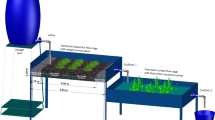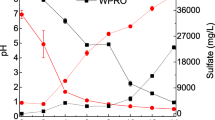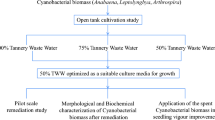Abstract
The objective of this study was to set-up a pilot plant and to evaluate its effectiveness for biological nitrogen and organic matter removal from tannery wastewater in Ethiopia. A pilot wastewater treatment plant consisting of a predenitrification-nitrification process was constructed and operated for 6 months. This was fed with a raw tannery wastewater obtained from the Modjo Tannery located 70 km south of the capital, Addis Ababa. Up to 98% total nitrogen and chemical oxygen demand, and 95% ammonium nitrogen removal efficiencies were achieved in the system. The average effluent ammonium nitrogen ranged from 8.4 mg l−1 to 86.0 mg l−1, whereas the average effluent for nitrate nitrogen ranged from 2.9 mg l−1 to 4.4 mg l−1. The average values of denitrification and nitrification rates determined by nitrate and ammonium uptake rates (NUR and AUR) were 8.0 mg NO3-N [g volatile suspended solids (VSS)]−1 h−1 and 5.4 mg NH4-N (g VSS)−1 h−1, respectively, demonstrating that the treatment processes of the pilot plant were effective. Further studies of the effect of chromium III on AUR showed 50% inhibition at a concentration of 85 mg l−1, indicating that this metal was not causing process inhibition during performance operations. Thus, the predenitrification-nitrification process was found to be efficient for simultaneous removal of nitrogen and organic substrates from tannery wastewaters.





Similar content being viewed by others

References
APHA (1992) Standard methods for the examination of water and wastewater, 18th edn. American Public Health Association, Washington D.C.
Banas J, Plaza E, Styka W, Trela J (1999) SBR technology used for advanced combined municipal and tannery wastewater treatment with high receiving water standards. Water Sci Technol 40:451–458
Basu M, Bhattacharya S, Paul AK (1997) Isolation and characterization of chromium resistant bacteria from tannery effluents. Bull Environ Contam Toxicol 58:535–542
Borzacconi L, Ottonello G, Castello E, Pelaez H, Gazzola A, Vinas M (1999) Denitrification in a carbon and nitrogen removal system for leachate treatment: performance of an up flow sludge blanket (USB) reactor. Water Sci Technol 40:145–151
Bosnic M, Buljan J, Daneils RP (2000) Pollutants in tannery effluents: limits for discharge into water bodies and sewers. Regional program for pollution control in the tanning industry in South East Asia, US/RAS/92/120. United Nations Industrial Development Organization, Vienna, pp 17–26
Cao GM, Zhao QZ, Sun XB, Zhang T (2002) Characterization of nitrifying and denitrifying bacteria co-immobilized in PVA and kinetics of model of biological nitrogen removal by co-immobilized cells. Enzyme Microb Technol 30:49–55
Cheremisinoff NP (1996) Biotechnology for waste and wastewater treatment. Noyes, Park Ridge, N.J.
Cloete TE, Muyima NYO (eds) (1997) Microbial community analysis: the key to the design of biological wastewater treatment systems. IAWQ No. 5, London
Collivignarelli C, Bertanza G (1999) Simultaneous nitrification–denitrification processes in activated sludge plants: performance and applicability. Water Sci Technol 40:187–194
Dangcong P, Bernet N, Delgenes JP, Moletta R (2001) Simultaneous organic carbon and nitrogen removal in an SBR controlled at low dissolved oxygen concentration. J Chem Technol Biotechnol 76:553–558. DOI 10.1002/jctb.419
Focht DD, Verstraete W (1977) Biochemical ecology of nitrification and denitrification. Adv Microb Ecol 1:135–214
Government of Ethiopia (GOE) (2002) Environmental pollution control proclamation. Nagarit Gazeta of the Federal Democratic Republic of Ethiopia, Proclamation No. 300/2002, Addis Ababa
Grunditz C, Gumaelius L, Dalhammar G (1998) Comparison of inhibition assays using nitrogen-removing bacteria: application to industrial wastewaters. Water Res 32:2995–3000
Gupta AB, Gupta SK (2001) Simultaneous carbon and nitrogen removal from high strength domestic wastewater in an aerobic RBC biofilm. Water Res 7:1714–1722
Gupta SK, Sharma R (1996) Biological oxidation of high strength nitrogenous wastewater. Water Res 30:593–600
Henze M (1991) Capabilities of biological nitrogen removal processes from wastewater. Water Sci Technol 23:669–679
Hirata A, Nakamura Y, Tsuneda S (2001) Biological nitrogen removal from industrial wastewater discharged from metal recovery processes. Water Sci Technol 44:171–180
Im JH, Woo HJ, Choi MW, Hi KB, Kim CW (2001) Simultaneous organic and nitrogen removal from municipal landfill leachate using an anerobic–aerobic system. Water Res 35:2403–2410
Jokela JPY, Kettunen RH, Sormunen KM, Rintala JA (2002) Biological nitrogen removal from municipal landfill leachate: low-cost nitrification in biofilters and laboratory scale in-situ denitrification. Water Res 36:4079–4087
Kajuwa K, Klapwijk B (2000) A method to estimate denitrification potential for predenitrification systems using NUR batch test. Water Res 33:2291–2300
Kotás J, Stasicka Z (2000) Chromium occurrence in the environment and methods of its speciation. Environ Pollut 107:263–283
Kristensen HG, Jorgensen PE, Henze M (1992) Characterisation of functional microorganism groups and substrate in activated sludge and wastewater by AUR, NUR and OUR. Water Sci Technol 25:43–57
Kuenen JG, Robertson LA (1988) Ecology of nitrification and denitrification. In: Cole JA, Ferguson SJ (eds) The nitrogen and sulfur cycles. Cambridge University Press, Cambridge, pp 161–218
Madoni P, Davoli D, Guglielmi L (1999) Response of sOUR and AUR to heavy metal contamination in activated sludge. Water Res 33:2459–2464
Metcalf and Eddy (1991) Wastewater engineering: treatment, disposal and reuse. McGraw-Hill, New York, pp 359–434
Mussati M, Gernaey K, Gani R, Jørgensen SB (2002) Performance analysis of a denitrifying wastewater treatment plant. Clean Technol Environ Policy 4:171–182. DOI 10.1007/s10098-002-0157-8
Philips S, Wyffels S, Sprengers R, Verstraete W (2002) Oxygen-limited autotrophic nitrification/denitrification by ammonia oxidisers enables upward motion towards more favourable conditions. Appl Microbiol Biotechnol 59:557–566. DOI 10.1007/s00253-002-1059-8
Pochana K, Keller J (1999) Study factors affecting simultaneous nitrification and denitrification (SND). Water Sci Technol 39:61–68
Stevens GM, Barnard JL, Rabinowitz B (1999) Optimization of nutrient removal in anoxic zones. Water Sci Technol 39:113–118
UNEP (1991) Tannery and the environment: a technical guide to reducing the environmental impact of tanning operations. UNEP/IEO, UN Publication series III, Paris
Weimann M, Schenk H, Hegemann W (1998) Anaerobic treatment of tannery wastewater with simultaneous sulphide elimination. Water Res 32:774–780
Wiegant WM, Kalker TJJ, Sontakke VN, Zwaag RR (1999) Full scale experience with tannery water management: an integrated approach. Water Sci Technol 39:169–176
Acknowledgements
This work was supported by the Swedish International Development Cooperation Agency (Sida/SAREC) through the East African Regional Programme and Research Network for Biotechnology, Biosafety and Biotechnology Policy Development (BIOEARN). The excellent technical and material support of Mr. Zeleke Teferi at the Addis Ababa Water and Sewerage Authority is highly acknowledged. Modjo and Ethiopia Tanneries deserve special thanks for their consistent support and permission to use the tannery wastewaters for this study.
Author information
Authors and Affiliations
Corresponding author
Rights and permissions
About this article
Cite this article
Leta, S., Assefa, F., Gumaelius, L. et al. Biological nitrogen and organic matter removal from tannery wastewater in pilot plant operations in Ethiopia. Appl Microbiol Biotechnol 66, 333–339 (2004). https://doi.org/10.1007/s00253-004-1715-2
Received:
Accepted:
Published:
Issue Date:
DOI: https://doi.org/10.1007/s00253-004-1715-2



